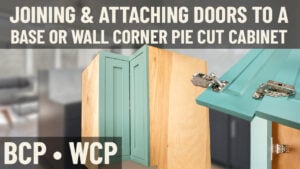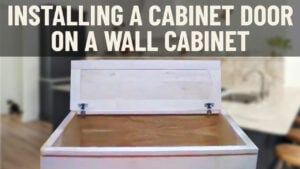Video Transcript
Introduction
Hey everyone, Brian from the Cabinet Joint here. No matter what kitchen you order—overlay or inset—you’re going to have to put hinges on a door. The doors do not come from the manufacturer with the hinges already in them. That would create a lot of damage and rubbing. So, one of the processes you’re going to be doing is some upfit, which involves putting the hinges on the doors themselves. Regardless of whether it’s an inset hinge or an overlay hinge, they come in packages like this with all the screws you’ll need.
It’s the same exact principle when you set the hinge in the cup to put it in. Tools are minimal. A square is optional; I’ll show you how you’ll use that. It just makes the hinge square in the cup—that’s optional. You can buy it if you want, but we don’t recommend it.
We use a self-centering bit, which allows me to put about a 1/2-inch deep hole in the door dead center because it’s tapered. Those are about seven bucks from Lowe’s. I’ve got a Phillips head bit, and then if you don’t have one of these, I’ve just got a drill with a normal, about a 3/32-inch drill bit in it. If you’re very careful and find the center of the hole in the hinge cup, you can do it that way if you don’t have one of these. Not that big of a deal.
Let’s get started and show you how to actually put the hinges in the door and get them hung on the cabinet.
Installing the Hinges
The hinges come in their own packages. They’re labeled whether it’s full overlay or inset hinges. They come in their own package. Just a quick bit of information: if you’re an inset customer, these hinges are meant to snap onto this bracket here. This bracket mounts behind the front frame, and the hinge snaps into it. You want to mount these brackets before the cabinet is built.
All this comes together in this package, but for this operation, we’re just going to pull the hinges out; we don’t need the brackets. That’s going to go on the cabinet itself. If it’s overlay, all you get is the two hinges and the four screws—very, very simple.
So here are my screws—two for each hole—and here are my hinges. These go in the same exact way. I’m just going to use this overlay hinge to demonstrate. I’m going to set the hinges in the cup. They just kind of press in. If they’re painted doors, you might have a little bit of a firm press because there’s some paint buildup in there, but they will go in.
Now is where I use my square. I’m going to take my square and run it along the edge of the door. You can see if this hinge is kicked this way, the square won’t square up. But as I push the square, I guarantee that my hinge is running parallel to the edge of the door.
Now I can take my pre-drill bit, and because of that taper that you see there, it’ll find its way into the very center of that hole, and I can get a perfect hole. If I don’t have one of those, I’m just using a 3/32-inch bit. I want to make sure the bit is set to not go all the way through the door. So, I’m going to adjust this in a little bit to make sure I’m only going down about 1/2 inch. Then I would just find the center of the hole as best I can and go in. I do not need to go all the way in. If I’ve got a longer bit sticking out, just make sure you don’t penetrate; I’m only going in about 1/2 inch.
Now I have this hinge dead straight. I can take my Phillips head, take one of the screws, and just go in until it stops. Don’t over-torque this, especially if your doors are MDF. Just go until it’s tight. If you overdrive it, it’ll just start to spin and augur out the hole, and now you have a screw that’s not holding fast.
I’m going to do the same thing on this one down here. It shouldn’t be a big deal—you get the idea.
Variations & Considerations
Something I want to mention about these hinges: you might see some doors from some manufacturers, like if you’ve got cabinets from Lowe’s or Home Depot, you’ll see there are two other holes over here, about an 8mm hole on either side. Those are what we call insert holes.
When you’re working with your cabinet codes, you’re going to see that your boring pattern calls for Pattern A for the overlay and Pattern B for the inset, but it says “cup only, no insert holes.” That is correct. This is not the insert hole—that’s the cup.
The insert holes are for press-in-style hinges, which a cabinet shop would have. A hinge press drills out those two holes and the big hole. They put the hinge into a press, pull a handle, and it presses the hinge into those little fluted dowels in those two 8mm holes.
You do not want that, so don’t fight your cabinet coach when they say, “No, you don’t want the insert holes.” No, you don’t. You want cup only. That’s why you’re actually mounting the hinge straight to the door with a wood screw. Very important difference.
If you’re a cabinet shop and you’ve got a hinge press, we’ll sell them to you that way, but most homeowners don’t.
There are other variations to hinges that we sell, whether it’s the 170° Lazy Susan hinges. It’s all variations on a theme. The hinge drops into the cup, you make sure it’s straight, run your two holes, and you’re good to go.
Summary
If you have any questions, obviously talk to your cabinet coach—they’re there to help you. This is probably one of the easiest things you’ll be doing with your assembly. It’s just monotonous, but it takes you about an hour to hinge all your doors, and then you’re ready to hang them.
There are separate videos that show how to take a door, like an inset door, snap it on, and adjust it, or how to install an overlay door. This video is just to show you how to put the door hinges on the door itself.
We hope this has been of help to you. Thanks for watching!





I appreciate you sharing this article post.Thanks Again. Awesome.
insurancewhisper
Hi Brian – Is there a way to adjust the Blum 1 1/4″ overlay hinges such that the cabinet door only opens 90 degrees? Currently the hinges allow the door to swing open past 90 degrees (maybe 120 degrees?) causing it to hit the adjacent greater depth cabinet. Was wondering if there’s a way for us to stop it at 90 degrees. Thanks very much!
This is what is used to restrict the opening of a door to 90 degrees…
https://www.amazon.com/dp/B00E966DQQ/ref=as_sl_pc_tf_til?tag=cabinet20-20&linkCode=w00&linkId=22885ffa5e9fb71fbd2ec56650d836cd&creativeASIN=B00E966DQQ
What drill bit / stop are you using here?
Rick – 9/64 in. (Or close) High Speed Steel Self-Centering Hinge Bit